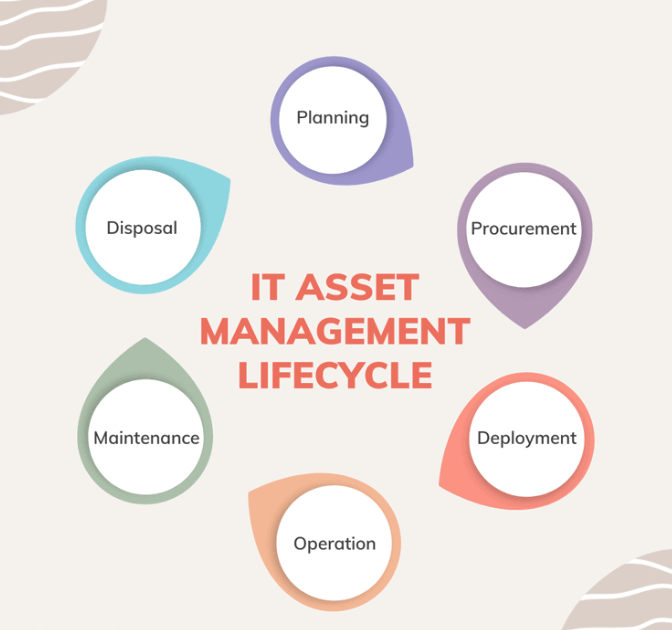

IT Asset Management (Image by IPWEA)


IT Asset Management (Image by IPWEA)
IT Asset Management (ITAM) is a systematic and strategic approach to govern and maximize the value of IT assets throughout their lifecycle.
It includes detailed oversight of IT resources, including hardware such as servers and laptops and software applications and licenses.
The goal is to know what assets are on hand, where they are located, how they are utilized, and whether they provide value to the business.
Moreover, effective IT asset management (ITAM) lays the groundwork for prospering IT project management.
ITAM helps ensure that projects are completed on time, within budget, with the desired quality, and aligned with the organization’s strategic goals.
Companies can ensure that their IT assets are well managed and aligned with their overall business goals and strategies by understanding and implementing ITAM.
To that end, this guide explores the essential elements of ITAM. It also identifies key strategies and practices that can improve effectiveness.
IT Asset Management (ITAM) is a strategic management method for company technology resources.
ITAM oversees IT assets’ entire life cycle, from procurement to disposal, to ensure their effective utilization and contribution to business goals.
ITAM is critical to the relationship between Managed Service Providers (MSPs), businesses, and IT departments.
ITAM provides a clear and structured way to manage IT assets efficiently in that triangular relationship.
The scope of ITAM is not just the tracking of physical assets but also hardware management, software management, and digital asset management.
As a result, ITAM has a strategic role in aligning IT resources with business objectives. How?
Because implementing IT Asset Management (ITAM) can benefit your business in several ways.
First, it allows you to optimize resources by preventing over-purchasing and underutilizing IT assets.
ITAM also improves decision-making by providing accurate data on IT asset performance and needs.
Another good news is that ITAM helps you manage costs effectively by tracking and analyzing IT spending.
Lastly, ITAM helps your business mitigate compliance, licensing, and cybersecurity risks through diligent management.
Asset identification and categorization are essential components in effectively managing IT resources. Adopting these practices results in optimized IT resource management.
When businesses and MSPs focus on these processes, they can ensure that their IT assets are well organized and aligned with their business needs.
Asset identification involves the systematic recognition of each IT asset within an organization.
This stage is critical to creating a comprehensive inventory of all IT assets, including hardware, such as computers and servers, and software, such as licenses and applications.
Once assets have been identified, the next phase is categorization. This is organizing assets based on various factors such as their function, location, or departmental use.
Effective categorization streamlines asset management and facilitates accessing information about each asset, simplifying resource allocation where most needed.
The ITAM process should follow the principal steps below for maintaining precise systems to achieve the asset identification and categorization strategy successfully.
Lifecycle management in IT Asset Management (ITAM) ensures the efficient and effective use of IT assets from acquisition to disposal.
This approach adds considerable value by optimizing IT asset performance and minimizing associated costs throughout their lifecycle.
The lifecycle systematic approach encompasses IT asset acquisition, deployment, maintenance, and retirement or disposal.
These steps provide a strategic framework to optimize IT asset usage while managing costs effectively.
During the acquisition stage, the focus is on selecting and purchasing the appropriate assets that meet the organization’s specific needs while delivering the most value.
Once the assets are acquired, the subsequent stage involves deploying them efficiently by installing, configuring, and integrating them into the existing IT environment.
Maintaining IT assets is essential for ensuring their optimal performance and longevity. It involves regularly updating, repairing, and monitoring them to meet your business needs.
The final stage is retirement or disposal, which requires securely disposing of or repurposing assets that are no longer efficient in a way that complies with legal and environmental standards.
Asset tracking technologies are significant in IT asset management (ITAM), especially for managed service providers (MSPs) and businesses that rely on an extensive IT infrastructure.
These advanced technologies, such as RFID, barcoding, and asset management software, provide efficient ways of establishing and sustaining precise and current IT asset records.
RFID (Radio Frequency Identification) uses electromagnetic fields to identify and track tags attached to assets automatically. RFID has a sophisticated ability to track assets without physical contact.
RFID can quickly and accurately track multiple assets simultaneously without the need for direct line-of-sight.
Meanwhile, barcoding simplifies asset-tracking technologies, making them affordable.
The result is an increase in the accuracy of your asset management.
In addition, asset management software provides a centralized platform for effective IT asset tracking and management: real-time updates and detailed reporting.
Compliance in ITAM requires ensuring that all IT assets and processes comply with specific regulatory requirements and industry standards. Both actions contribute to the success and reputation of your business.
Compliance and security measures include adherence to laws and regulations related to data protection, privacy, and security.
Compliance helps businesses avoid legal penalties, enhances their reputation, and builds trust with customers and stakeholders.
At the same time, ITAM security measures aim to protect sensitive data and prevent unauthorized access or breaches.
Implementing robust cybersecurity protocols, access controls, and regular security audits is vital in preventing data breaches, safeguarding assets from cyber threats, and ensuring data integrity and confidentiality.
MSPs and businesses must implement effective compliance and security measures to manage their IT assets responsibly and securely.
Effective cost optimization and budgeting ensure IT investments align with the organization’s financial capabilities and strategic goals.
Cost optimization in IT Asset Management (ITAM) involves strategically managing IT assets to trim unnecessary expenses and add more value.
This encompasses effective asset utilization, lifecycle management, and vendor negotiation.
Budgeting in ITAM necessitates a comprehensive comprehension of current and future IT asset needs and aligning them with the organization’s financial plan.
This implies precise forecasting, cost-benefit analysis, and regular review and adjustments.
By managing IT assets adeptly and aligning them with financial objectives, organizations can ensure prudent technological investments, resulting in enhanced financial performance and competitive advantage.
This strategic financial approach to ITAM enables informed decision-making, maximizes IT investment value, and achieves long-term financial stability.
Vendor Management and Procurement are vital components of effective IT asset management (ITAM).
These practices provide value by acquiring IT assets that adhere to quality standards and budgetary limitations.
With strategic vendor relationships and skilled negotiations, MSPs and your businesses can guarantee the optimization of their IT asset investments, improving their operational efficiency while fulfilling their strategic objectives.
Effective vendor management involves selecting and managing suppliers to procure the optimal IT assets.
Effective vendor management involves selecting and managing suppliers to acquire the optimal IT assets. It is crucial due to its ability to:
To get those benefits, we need to adopt best practices in the procurement process, such as
And, for sure, the relationship must be positive and mutually profitable. Successful sourcing depends on negotiating and maintaining positive supplier relationships. That best practice relationship involves:
Risk management and mitigation in IT asset management (ITAM) is a crucial approach that MSPs and businesses must take to protect their IT assets from various risks.
Risk management involves identifying potential associated risks, assessing their impact, and developing a risk management plan.
This assessment will help prioritize risks based on their potential impact. Meanwhile, strategies for mitigating risks comprise:
MSPs and businesses can safeguard their IT assets from a wide range of threats by creating a comprehensive risk mitigation plan.
This plan involves identifying potential risks, evaluating their impact, and implementing effective mitigation strategies.


Cloud and virtual assets epitomize a significant change in managing and utilizing IT resources.
That is why MSPs and businesses must comprehend the distinctiveness of these assets and implement strategic management practices.
Generally, cloud assets are remote services and resources, like cloud storage, applications, and computing power, accessed and managed over the internet.
Virtual assets comprise virtual machines, virtual networks, and other software-created resources that exist in a non-physical environment.
Maintaining visibility and control is a crucial hurdle in managing cloud and virtual assets.
Given that these assets lack physical presence, maintaining track of their performance and usage can prove intricate.
Effective management of cloud and virtual assets requires improved visibility, security measures, optimization strategies, and establishing compliance and governance protocols.
In ITAM, reporting involves documenting and presenting data systematically regarding IT assets, such as their utilization, performance, maintenance, and costs.
Analytics takes it further by interpreting such data to identify patterns, trends, and predictions.
The combination of reporting and analytics converts raw data into actionable intelligence, enabling managers to make informed decisions.
In strategic planning, these actions assist with operational decisions, long-term investment strategies, budgeting, and overall business strategy.
Aligning IT asset management with broader organizational goals, reporting, and analytics guarantees that IT resources make an optimal contribution to business success.
Asset management in ITIL 4 ensures that all types of assets are effectively managed to support service delivery.
This concern requires an understanding of the lifecycle of each type of asset, from acquisition through operation to retirement, and its alignment with the service value system.
Additionally, ITIL 4 considers that assets are physical devices or software and include non-tangible elements such as intellectual property, contracts, and information.
Types of Asset Management in ITIL 4 include:
The approach in ITIL 4 is to manage assets in a manner that maximizes their support of service management processes.
The objective is to ensure efficient use of assets, effective management of risks, and alignment of asset investments with business objectives and customer needs.
IT asset management (ITAM) is vital to IT service management (ITSM), especially for Managed Service Providers (MSPs) and businesses.
ITAM enhances ITSM’s value by providing a structured approach to managing IT resources.
Specifically, ITAM, within the context of ITSM, entails the detailed process of tracking and managing IT hardware, software, and resources throughout their lifecycle, including procurement, deployment, maintenance, and disposal of IT assets.
Integrating ITAM into ITSM aims to guarantee that IT services are bolstered by optimal infrastructure and resources.
This integration assures that the IT services are backed by cost-effective, dependable assets that align with the specific business requirements.
In IT Asset Management (ITAM), the ultimate goal is to get the most out of every asset, manage costs effectively, and oversee an asset’s entire lifecycle- from when it is purchased until it is eventually retired.
This undertaking includes asset identification and categorization, careful management throughout each stage of their life cycle, and vigilance against potential risks.
The challenge for Managed Service Providers (MSPs), businesses, and IT departments is managing IT assets effectively to improve service delivery while aligning with your financial and operational objectives.
That’s the challenge Octobits addresses. Envision a platform that simplifies ITAM complexities, delivering a seamless and cohesive experience.
Octobits make it easy to track user and device information, oversee licensing details, manage billing, and stay on top of alerts.
Our dashboard puts everything in perspective, our login system streamlines your daily operations, and our billing and reporting process is incredibly efficient. With Octobits, it’s all about achieving harmony in your IT world.
Picture a scenario where your IT environment perfectly aligns with industry leaders such as Datto Autotask, Microsoft 365, Azure, AWS, CrowdStrike, and Proofpoint.
Octobits is not just a tool but the genius behind a synchronized and optimized IT environment tailored to your company’s needs.
Consider the possibilities that arise when you join forces with Octobits. It’s an invitation to share your journey, ask questions, and explore how this partnership could revolutionize your approach to IT.
Please take a moment to visit the Octobits website and discover how our specialized services can propel your business into the rapidly evolving digital landscape.
It’s time to take that step with Octobits, guiding you towards a future where your IT infrastructure is more than just managed – it’s transformed.